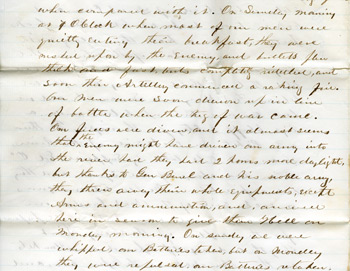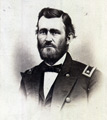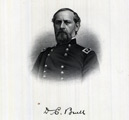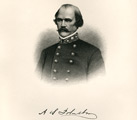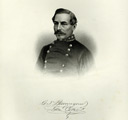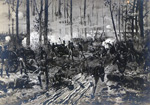Click Center Image for Full Size Picture
After taking Fort Henry and Fort Donelson in Tennessee in February 1862, Major General U. S. Grant was ordered to advance up the Tennessee River. By early April, most of Grant's Army of the Tennessee had arrived at Pittsburg Landing, where they were ordered to await Major General Buell's Army of the Ohio in preparation for further campaigns. While waiting, Grant chose not to fortify his position, choosing instead to drill his men, many of whom were raw recruits.
Confederate General A. S. Johnston and his Army of Mississippi had fallen back to Corinth, Mississippi, to reorganize after the loss of the two forts. Johnston was determined to attack the Union forces at Pittsburg Landing before they could be reinforced for their next campaign.
The Confederate Army's attack early Sunday morning, April 6, took the Union by surprise, initially overwhelming them. Union soldiers made a determined stand in a sunken road that came to be known as the "Hornet's Nest." That action allowed other Union units to pull back and establish a battle line covering Pittsburg Landing. Johnston was killed during the fighting, and his second-in-command, Confederate General P. G. T. Beauregard, took charge. As the sun set, Beauregard called off further attacks, and both sides spent a miserable night in the rain. That evening and during the night, Buell's fresh troops arrived to reinforce the Union.
Pittsburg Landing, Tennessee River, Tennessee.
It was the Confederate Army's turn to be surprised by the Union's counterattack at dawn on April 7. Throughout the day, Beauregard's army was pushed back until he conceded that the battle could not be won and withdrew to Corinth.
Cheney's Battery arrived at Pittsburg Landing on April 9, too late to join the other batteries of the 1st Illinois Light Artillery in the Battle of Shiloh. Cheney recorded an account of the battle in his April 12 letter to Mary, perhaps given to him by other "Dixon boys" in the 34th and 46th Illinois Infantry Regiments who had participated. After riding over the battlefield, Cheney described it as "a horrible sight." Cheney credited Buell and "his noble army" with saving the day, criticizing Grant for letting his army be taken by surprise. "I think it is high time that such men be removed," Cheney wrote. He was not alone in his criticism of Grant. Calls for Grant to be removed prompted President Abraham Lincoln's famous reply, "I can't spare this man; he fights."
